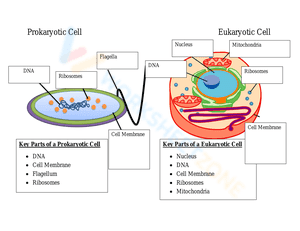All life forms, from tiny bacteria to towering giant Sequoias, are considered to be biotic elements of the environment. On a microscopic scale, however, every living thing is composed of the same fundamental building block, the cell. The cell is defined as the structural and functional foundation of all living organisms. Anatomically, as cells differ according to their classification, prokaryotic and eukaryotic cells are also very different from one another. A prokaryotic cell is a primitive type of cell that is characterized by the absence of a nucleus. Prokaryotes, which are only unicellular organisms, also lack cellular organelles that are attached to membranes. On the other hand, eukaryotic cells are those that have a real nucleus and organelles that are attached to membranes. Eukaryotes can be unicellular or multicellular. If you are struggling with problems concerning prokaryote and eukaryote cells, please don’t be worried, we have provided various useful prokaryote and eukaryote worksheets for extra practice. You can use these biology worksheets to test your knowledge of prokaryotic and eukaryotic cells and how they differ from one another. You will be able to look at the distinctions between eukaryotic and prokaryotic cells and discover how they are related. Try these prokaryote and eukaryote worksheets if you're seeking a means to reteach and offer extra help when it comes to prokaryote and eukaryote cells. We’re sure that it would be a great reinforcement activity.
Periodic TableBalancing ActConservation Of MassClassifying MatterLab SafetyChemical Bonding Ionic And CovalentAcid NamingBalancing Chemical EquationsHesss LawColligative PropertiesNet Ionic EquationLe Chatelier's PrincipleNaming Molecular CompoundsMole RatioNova Hunting The ElementsCalculating Average Atomic MassEndothermic And Exothermic ReactionNaming Ionic CompoundsStoichiometryMetals Nonmetals And MetalloidsNaming AlkanesMixtures And SolutionsMole To Grams Grams To Moles ConversionsAtoms Isotopes And IonsEmpirical/Molecular Formula PracticePredicting Products Of Chemical ReactionsSolubility CurveIntermolecular ForcesProtons Neutrons And Electrons PracticeIsotope PracticeNaming Covalent CompoundsPercent CompositionTypes Of ReactionClassifying Chemical ReactionsConjugate Acid Base PairsDalton's Law Of Partial PressureGrahams LawPeriodic TrendsCounting AtomsAssigning Oxidation NumbersSingle Replacement ReactionPh And Poh CalculationsLab EquipmentLimiting ReactantNeutralization ReactionsMolar MassElectron Configuration PracticeHistory Of An AtomBohr ModelIntegrated Science CyclesPhotosynthesisOn Nitrogen CycleMacromoleculeBiogeochemical CyclesBalanced And Unbalanced ForcesKaryotypeThe Carbon CycleInsulin To Carb Ratio
Allfiltered results





